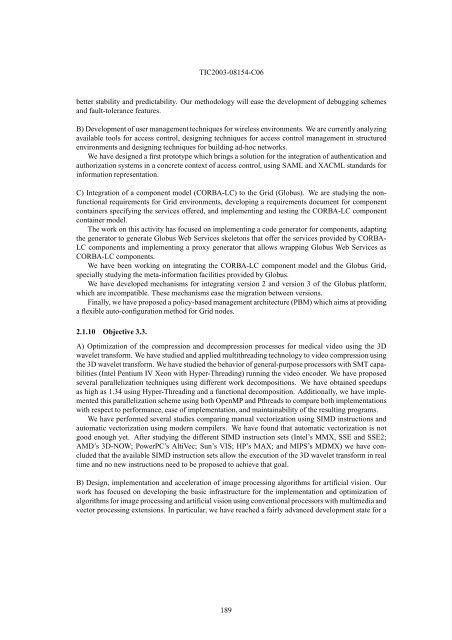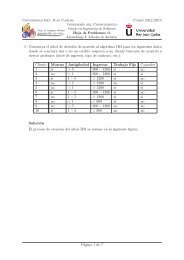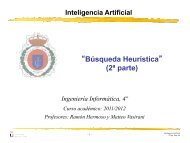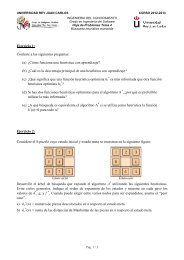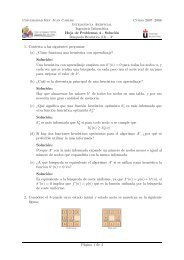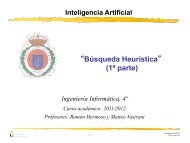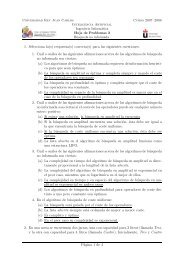GLIRS-II - Grupo de Inteligencia Artificial - Universidad Rey Juan ...
GLIRS-II - Grupo de Inteligencia Artificial - Universidad Rey Juan ...
GLIRS-II - Grupo de Inteligencia Artificial - Universidad Rey Juan ...
Create successful ePaper yourself
Turn your PDF publications into a flip-book with our unique Google optimized e-Paper software.
TIC2003-08154-C06<br />
better stability and predictability. Our methodology will ease the <strong>de</strong>velopment of <strong>de</strong>bugging schemes<br />
and fault-tolerance features.<br />
B) Development of user management techniques for wireless environments. We are currently analyzing<br />
available tools for access control, <strong>de</strong>signing techniques for access control management in structured<br />
environments and <strong>de</strong>signing techniques for building ad-hoc networks.<br />
We have <strong>de</strong>signed a first prototype which brings a solution for the integration of authentication and<br />
authorization systems in a concrete context of access control, using SAML and XACML standards for<br />
information representation.<br />
C) Integration of a component mo<strong>de</strong>l (CORBA-LC) to the Grid (Globus). We are studying the nonfunctional<br />
requirements for Grid environments, <strong>de</strong>veloping a requirements document for component<br />
containers specifying the services offered, and implementing and testing the CORBA-LC component<br />
container mo<strong>de</strong>l.<br />
The work on this activity has focused on implementing a co<strong>de</strong> generator for components, adapting<br />
the generator to generate Globus Web Services skeletons that offer the services provi<strong>de</strong>d by CORBA-<br />
LC components and implementing a proxy generator that allows wrapping Globus Web Services as<br />
CORBA-LC components.<br />
We have been working on integrating the CORBA-LC component mo<strong>de</strong>l and the Globus Grid,<br />
specially studying the meta-information facilities provi<strong>de</strong>d by Globus.<br />
We have <strong>de</strong>veloped mechanisms for integrating version 2 and version 3 of the Globus platform,<br />
which are incompatible. These mechanisms ease the migration between versions.<br />
Finally, we have proposed a policy-based management architecture (PBM) which aims at providing<br />
a flexible auto-configuration method for Grid no<strong>de</strong>s.<br />
2.1.10 Objective 3.3.<br />
A) Optimization of the compression and <strong>de</strong>compression processes for medical vi<strong>de</strong>o using the 3D<br />
wavelet transform. We have studied and applied multithreading technology to vi<strong>de</strong>o compression using<br />
the 3D wavelet transform. We have studied the behavior of general-purpose processors with SMT capabilities<br />
(Intel Pentium IV Xeon with Hyper-Threading) running the vi<strong>de</strong>o enco<strong>de</strong>r. We have proposed<br />
several parallelization techniques using different work <strong>de</strong>compositions. We have obtained speedups<br />
as high as 1.34 using Hyper-Threading and a functional <strong>de</strong>composition. Additionally, we have implemented<br />
this parallelization scheme using both OpenMP and Pthreads to compare both implementations<br />
with respect to performance, ease of implementation, and maintainability of the resulting programs.<br />
We have performed several studies comparing manual vectorization using SIMD instructions and<br />
automatic vectorization using mo<strong>de</strong>rn compilers. We have found that automatic vectorization is not<br />
good enough yet. After studying the different SIMD instruction sets (Intel’s MMX, SSE and SSE2;<br />
AMD’s 3D-NOW; PowerPC’s AltiVec; Sun’s VIS; HP’s MAX; and MIPS’s MDMX) we have conclu<strong>de</strong>d<br />
that the available SIMD instruction sets allow the execution of the 3D wavelet transform in real<br />
time and no new instructions need to be proposed to achieve that goal.<br />
B) Design, implementation and acceleration of image processing algorithms for artificial vision. Our<br />
work has focused on <strong>de</strong>veloping the basic infrastructure for the implementation and optimization of<br />
algorithms for image processing and artificial vision using conventional processors with multimedia and<br />
vector processing extensions. In particular, we have reached a fairly advanced <strong>de</strong>velopment state for a<br />
189


